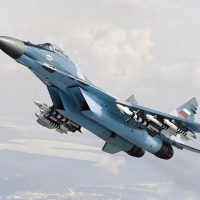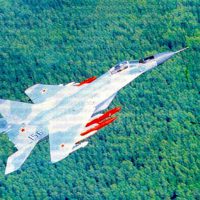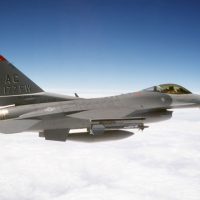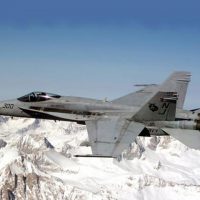Comparison
 West comparing
West comparing the modernised F-16C and F-18C with the first series MiG-29s, which date back to 1982-1984, are incorrect. It would be more correct to compare these [F-16C and F-18C] aircraft with the MiG-29s built in the last [few] years and the MiG-33. We did this in the attached tables. Among others, there are the following advantages of the MiG-29 and the MiG-33 over the F-16C and the F-18C:
the modernised F-16C and F-18C with the first series MiG-29s, which date back to 1982-1984, are incorrect. It would be more correct to compare these [F-16C and F-18C] aircraft with the MiG-29s built in the last [few] years and the MiG-33. We did this in the attached tables. Among others, there are the following advantages of the MiG-29 and the MiG-33 over the F-16C and the F-18C:
– The MiGs feature more complex aiming systems, incorporating the radar, the OESS and the helmet-mounted sight meanwhile the American fighters have [only] radars and visual aiming at targets.
– The MiGs have radars with wider scan and track angles in azimuth: +/-60 degress for the F-16C, +/-70 for the MiG-29 and the F-18C, +/-90 for the MiG-33.
 The MiGs
The MiGs  have wider zones of target had-off designation for short air-to-air missiles suspended under pylons: +/-28 degrees for the AIM-9 [Sidewinder] and +/-45 degrees for the R-73 [NATO code name Archer] as well as wider target-tracking angles after launch 45 deg for the AIM-9 and 75 deg for the R-73.
have wider zones of target had-off designation for short air-to-air missiles suspended under pylons: +/-28 degrees for the AIM-9 [Sidewinder] and +/-45 degrees for the R-73 [NATO code name Archer] as well as wider target-tracking angles after launch 45 deg for the AIM-9 and 75 deg for the R-73.
– The Russian aircraft’s assigned calendar lifetime is longer (25 years). This has been proved by the operational experience of the previous models (the MiG-21, the MiG-23 and the MiG-29).
– The MiGs have more effective, in terms of accuracy, methods of gun firing which are coupled with the larger calibre of the cannon (30-mm against 20-mm).
– The twin-engine MiG-29 has better flight safety compared with the single-engine F-16.
Economical factors are of great significance when it comes to choosing what type of aircraft to buy. Their influence is the key to understanding why the majority of nations (about 80 countries) prefer to buy only light-weight fighters like the MiG-29, the F-16, the F-18, and the Mirage 2000. Heavy-weight fighters, the F-15 and the Su-27, can be found in service only in the CIS, the USA, Saudi Arabia, Japan, Israel and China. Furthermore, in these countries their share is less than that of light-weight fighters. Economical characteristics, i.e. the acquisition cost and the maintenance cost, are also favourable to the MiG-29 and the MiG-33. After 20 year service life, the economical benifit, generated by a MiG-29 in comparison with an F-18C would have generated an equivalent sum equal to the acquisition cost charged for a new MiG-29.
The advantage of the MiG-29 and the MiG-33 over the Mirage 2000-5 can also be demonstrated in the same way. New designs, the Rafale and the EFA, will merely be able to get nearer to the MiG-33 or its further modifications in terms of tactical characteristics, albeit both will be much more expensive.
| MiG-33 | MiG-29 | F-16C | F-18C | |
| Take-off weight (full fuel, AAMs), kg. | 15,300 | 15,700 | 12,004 | 16,800 |
| Thrust with afterburners, kgf. | 2*8,300 | 2*8,800 | 1*12,518 | 2*7,620 |
| Max. speed at sea level, km/h. | 1,500 | 1,500 | 1,470 | 1,300 |
| Max. speed at high altitude, km/h. | 2,450 | 2,500 | 1,890 | 1,900 |
| Range w/out drop tanks at low level, km. | 710 | 900 | 800 | 950 |
| Range w/out drop tanks at altitude, km. | 1,500 | 2,000 | 2,000 | 2,200 |
| Thrust-to-weight ratio | 1.09:1 | 1.15:1 | 1.04:1 | 0.86:1 |
| Max. g load | 9 | 9 | 9 | 9 |
| Rate of climb, m/s | 252 | 234 | 194 | 210 |
| Turn rate, degree/s | 23.5 | 22.8 | 21.5 | 20 |
| High-speed interception range, km. | 345 | 410 | 389 | 370 |
| Low-level penetration mission range, km. | 340 | 385 | 400 | 372 |
| Radar aerial target detection range | ||||
| – (RCS=3sqm), km. | 60-70 | 80 | 50-60 | 60-65 |
| Maximum AAM launch range | ||||
| – head-on | 60 | 50 | 45 | 48 |
| – tail-on | 27 | 20 | 18 | 18 |
| Number of weapons hardpoints | 6 | 9 | 9 | 8 |
| Bomb load, tonne | 4 | 4.5 | … | 4.3 |
| Combat readiness coefficient | 0.9 | 0.9 | 0.8 | 0.85 |
| Maintenance man-hours per flight hour | 11.3 | 11.0 | 18 | 16-18 |
| Mean time between failures | ||||
| – in the air and on the ground, hour | 13.6 | 7.3 | 2.9 | 3.7 |
| Airframe lifetime, hours | 7,000 | 7,000 | 8,000 | 8,000 |
| Relative cost | 0.7 | 0.8 | 0.7 | 1.0 |
Authors: Anatoly Belosvet, Mikoyan design bureau, deputy general designer, Yuri Polushkin, Mikoyan design bureau, branch manager
Demonstrated for the first time at Farnborough-94, the MiG-33, a new Russian fighter, is a deep modernisation of the MiG-29. The main goals of the modernisation were:
- multifunctionality with further growth of air-to-air and air-to- ground capability widely using high-precision weapons
- considerable growth of combat range owing to an increase in the internal fuel capacity
- better pilot-to-aircraft interface in the cockpit
- introduction of new-generation equipment. The external changes between the MiG-33 and the MiG-29 are negligable and confined chiefly to the following:
- Changes in the intakes’ geometry including the removal of the upper intake louvres, enlarging inlet dimensions for higher airflow, installation of movable nets protecting the engines from the ingestion of foreign objects during take-off and landing
- The number of hard points has been increased up to nine and this enables either suspension of a 4,5 tonne bomb load or eight [Vympel] RVV-AE air-to-air missiles [Russian counterpart to the AMRAAM]
The MiG-33 can carry same types of missiles as the MiG-29 does, and many more. For instance, four air-to-surface missiles such as laser-guided Kh-25ML and Kh-29L, or TV-guided Kh-29T missiles or four KAB-500KR guided bombs can be carried .
The number of changes invisible for the eyes of a spectator is greater. The MiG-33 features more powerful, upgraded engines and the quadraple-redundant fly-by-wire flight control system. A new onboard radar with a reprogrammable signal processor provides not only a greater aerial target detection range, but is also capable of detection of sea and small-sized ground targets, ground mapping, terrain following and alerting to avoid ground obstacles.
A new electro-optical sighting system (EOSS) provides a growth in the target acquisition range, all-aspect target acquisition and the capability of illuminating a ground target with the laser laser beam. It also can detect a “laser spot” being created by an external designator, identify targets and track automatically ground targets with the help of the TV-channel. Modern interior of the cockpit features EFIS [electronic flight-instrumental system] (two multi-function displays, a head-up display, a track-and-alert system indicator). Besides, the MiG- 33 has more effective computers, running new software along with [modern] communication, friend-or-foe identification and electronic warfare systems.
In an effort to reduce the weight and the number of manufacturing hours as well as to achieve a higher level of quality, the forward fuselage (including the cockpit section) is made of aluminium-lithium alloy by means of welding. A variety of systems and devices have been modernised, including the landing gear.
The flight performance and the handling qualities either remain the same [as those of the MiG-29] or boast an improvement, this is due to the new engine and the fly-by-wire system. The combat range saw a considerable increase owing to the enlarged fuel capacity. For an aerial close-in engagement (five 360-degree turns, load of two medium, two short range missiles, three drop fuel tanks) the combat radius is 1,250 km. The subsonic interception mission range (M=0.85, armament of four medium range missiles, three drop fuel tanks) is 1,440 km, and for a ground target attack mission with air-to-surface missiles (load of two air-to-surface, two short range air-to-air missiles, three drop fuel tanks) the comabt radius is 1,190 km.